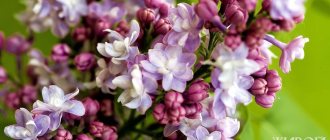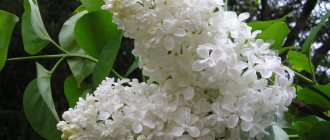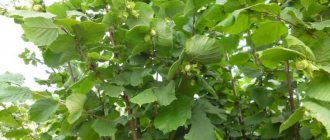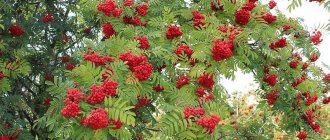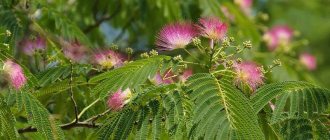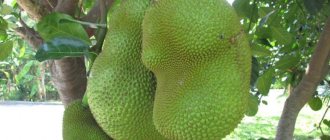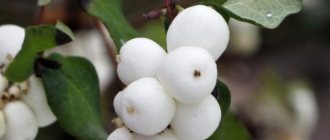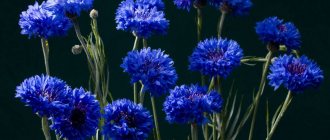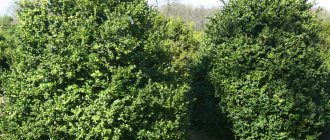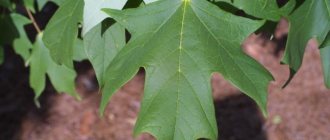Honey locust three-spined is an original decorative deciduous tree with fragrant flowers, covered with three-branched sharp spines. Sometimes the plant is called American acacia, since the tree is native to North America. However, honey locust has no relation to the Acacia genus. Popular for urban landscaping and hedges, honey locust wood is dense and durable with a beautiful texture.
Description of the species
Common or three-thorned honey locust (Gleditsia triacanthos) is a species of tree of the genus Honey locust, legume family. The plant reaches 35–40 m in height and 70–80 cm in diameter. The crown of the tree is openwork, pyramidal, spreading. Gleditsia triacanthos grows quickly, the greatest growth at the age of 5–7 years is 70 cm. The dark brown trunk and shoots are covered with large spines up to 15 cm long. The bark is thin and wrinkled. The root system is branched, strong, and penetrates deep into the soil.
The leaves of Gleditsia triacanthos are glossy, light green in summer and yellow in autumn, pinnate or double pinnate. They consist of 20–25 small oblong leaves, arranged in pairs along the main stem. The flowers of honey locust are white-green with a pleasant aroma, inconspicuous and small, collected in inflorescences. It blooms from 10 years old, annually from May to July. Fruits in late October. The red-brown pods are 20–40 cm long, curved and twisted, and remain on the tree until mid-winter. Three-spined honey locust pods with juicy sweet pulp. The seeds are elongated, brown, up to 15 mm in length.
The species is unpretentious, resistant to drought and winds, but is not frost-resistant - it can only withstand temperatures down to –23 °C. The lifespan of honey locust is about 200 years.
Species of the genus
There are certain varieties within the genus Gleditsia. They differ from three-spined (ordinary) in their size, appearance of fruits and leaves, thorns, and origin.
The most common plant species:
- Chinese honey locust (Gleditsia sinensis) is a heat-loving tree that grows in southern China. The plant has a lush and voluminous crown, the flowers are arranged in white tassels. The color of the bark has a reddish tint.
- Sweet honey locust is a tree about 16 meters high, has single spines, white flowers, which are particularly fragrant.
- Japanese honey locust (Gleditsia japonica) is found geographically in the Far East and is resistant to low temperatures. The height of the tree reaches approximately 20 meters, has pair-pinnate green leaves and red pods.
- Caspian honey locust (Gleditsia caspica) is a rather rare species that can be found in eastern Asia. The plants are not very tall, their height does not exceed 10 meters. They grow in the form of shrubs and have large leaves of a light green hue.
- Weeping honey locust has an elegant shape and has branches hanging down.
There are several varieties of honey locust
Spreading
In its natural environment, honey locust grows in the forests of eastern North America. In countries with temperate climates, the crop has been grown since the 18th century, in Russia - since the beginning of the 19th century. Gleditsia triacanthos is widespread in Ukraine and in southern Russian regions: in the Rostov and Volgograd regions, in the Krasnodar Territory, in the Crimea and in the North Caucasus. Despite the heat-loving nature, with the help of selection, some varieties are adapted to the climate of the middle zone, the Far East and the North-West, and in Siberia they are cultivated in botanical gardens.
Chemical composition
Fresh leaves of honey locust contain up to 1% triacanthin alkaloid and 100-400 mg of vitamin C. The flowers contain enanth ester, which gives a specific smell. The leaves also contain 0.3% alkaloids.
Ascorbic acid is present in the fruits, as well as in the leaves.
The thick walls of the fruit contain up to 29% sugar and 278 mg of vitamin C. The peel also contains 2.6% anthraglycosides and 3.1% tannins. The seeds contain the carbohydrate mannogalactan, which converts galactose and manose during hydrolysis, as well as mucus from the endosperm powder, which accounts for up to 25-40% of the weight of the seeds.
Honey locust contains many valuable components
Planting and care
Three-spined honey locust is unpretentious and is able to live in environmentally polluted areas and tolerates increased dust and air pollution. The species is resistant to winds and droughts, grows on saline soils, and easily tolerates replanting. For planting, choose a sunny, flat place; for the first 2 years, young seedlings are shaded. Seedlings 2–3 years old are preferred.
It is possible to grow honey locust on calcareous and sandy soils, but acidic and waterlogged soil is undesirable. Seedlings can be purchased from a nursery, making sure that the tree is not damaged or infested with parasites. It should be transported carefully - the shoots of the tree are brittle and easily damaged, which subsequently leads to pain in the plant.
Three-thorned honey locust is planted in spring or early autumn. The seedlings must have time to take root in the new place before the first frost. Gleditsia triacanthos is not winter hardy. It tolerates only short-term drops in temperature, so shelter is necessary in the cold season. To do this, use spruce branches, dry branches or special non-woven material.
The young tree is replanted with a clod of earth. An important condition is that the soil should not be waterlogged. Planting stages:
- A hole is dug 1.5–2 times larger than the earthen clod.
- To prevent moisture stagnation, add a drainage layer (small pebbles, crushed bricks, crushed stone, gravel)
- The honey locust is placed in a hole and the location of the trunk is recorded.
- The species is not picky about soil and fertilizers, so the resulting voids are filled with ordinary garden soil, watered and compacted.
- Three-spined honey locust is placed so that the root collar is at ground level.
- Water, compact the soil, gently loosen without damaging the roots, and mulch with a thick layer of straw, chopped bark or compost.
Further care is simple and consists of fertilizing with liquid mineral fertilizers once a year and removing weeds while the tree is growing. During periods of lack of precipitation, young plants require regular irrigation 1–2 times a month; adult honey locusts do not need watering.
Three-spined honey locust lends itself well to pruning; during decorative cultivation, the lower spines are removed and a crown is formed.
How to Succeed
Honey locust needs plenty of sunlight, but at the same time the plant is not afraid of a little shade. There are no requirements regarding the composition and fertility of the soil on the site. Saline and heavy soil for honey locust will not be a problem. Wetlands should not be used, as excessive moisture will kill the subtropical representative. The plant has excellent drought resistance. Only young growth needs abundant watering. If there is no rainfall during the summer months, the tree should be watered. Feeding is not necessary for honey locust, but a properly selected composition will speed up the growth of the plant.
What challenges do gardeners face?
In the first years there will be no inflorescences on honey locust. Fruiting will begin after the honey locust reaches 10 years of age. The tree is long-lived and can grow for a century. With the onset of spring, young shoots may not appear. This is not considered a problem, since young growth is only capable of forming rosettes of foliage. The plant is not predisposed to diseases. Leaf beetles and bugs pose a danger to honey locust, as they do to any other plant. Timely treatment of the tree with specialized preparations will help avoid the appearance of harmful insects.
Reproduction
Gledicia three-spined takes root easily. The species can be propagated both by seeds and vegetatively - by grafting, cuttings and root shoots:
- To prepare cuttings, cut branches with live buds are used. The shoots are rooted in a mixture of sand and soil.
- Shoots appear on plants at 8–10 years of age; replanting is carried out in the spring.
- Seed propagation is an effective way to obtain seedlings. Seeds can be stored in the refrigerator for a long time without losing their germination. They have a dense shell, so before sowing they are wiped with sandpaper. This helps to break the integrity of the shell and facilitates germination. Before planting, soak for 24 hours.
Soil moisture is important during germination. Seeds and cuttings can be planted immediately in open ground or left to grow in containers for 2–3 years.
Contraindications
Despite the fact that honey locust is used to obtain natural and safe raw materials that can be used for treatment and prevention, the plant has certain contraindications.
The tree contains the alkaloid triacanthin. It has poisonous properties.
That is why, in case of overdose, signs of toxic effects on the body may appear:
- headache;
- nausea and vomiting;
- decreased blood pressure;
- diarrhea;
- increased secretion of saliva;
- drowsiness;
- loss of consciousness.
If signs of overdose and poisoning appear, you should immediately seek medical help to cleanse the body of toxic substances. Otherwise, hemolysis of red blood cells and malfunction of the liver and kidneys may occur. If you have chronic diseases, consult your doctor before using any honey locust based products.
Headache is a sign of honey locust intoxication
Diseases and pests
Common honey locust has good immunity; the species is rarely attacked by pests. But constant soil moisture is detrimental to the plant, leading to damage to the roots by pathogenic fungi. Infection of the root system with gray mold (Botrytis cinerea) can lead to rotting and death of the plant. The proliferation of the parasite is facilitated by cold, rainy weather, waterlogging of the soil, lack of air circulation and sudden temperature changes in summer and spring. For prevention, a solution of copper sulfate is used, and for treatment, fungicides are used.
In addition to microorganisms, Gleditsia triacanthos can infect insects: garden bugs and aphids. Insecticides are used for destruction. Aphicides help well against aphids.
Home remedies from honey locust
Since the culture is not accepted in traditional medicine, homemade medicines are made from the leaves and fruits. The main use of honey locust is due to the use of decoctions and infusions based on the active substance.
- Decoctions of honey locust are made for the treatment of stomach and intestinal ulcers. A decoction of the leaves and fruits of the tree helps normalize blood circulation and lower blood pressure. To prepare the decoction, 10 beans of the plant are crushed. the resulting powder is poured with half a liter of hot water and boiled for a quarter of an hour. after which the mixture is allowed to cool. It is necessary to use the decoction for the treatment of gastritis for half a month, take a tablespoon before meals. It is important to understand that a decoction of fruits has a much greater effect than a decoction of leaves.
- An infusion from parts of the culture has wound-healing and anti-inflammatory properties. To prepare it, use a spoonful of leaves, crushed in a blender. The resulting mixture is added to a saucepan with a glass of boiling water. After which the infusion is kept over the fire for half an hour and cooled. The finished mixture is passed through cheesecloth and consumed in a teaspoon for a month, 4-5 times a day.
- To treat constipation, the following infusion recipe is used: a tablespoon of crushed leaves and beans is poured into a glass of boiling water. The resulting mixture is left covered for a quarter of an hour. then it is filtered and taken one tablespoon at a time throughout the day.
It is important to understand that a large amount of decoction and infusion can lead to negative complications, so self-medication is unacceptable. In addition, honey locust treatment should not replace basic medicine and medications. It is only permissible to use decoctions and infusions for prevention to enhance the effect of traditional treatment.
Meaning and Application
Honey locust wood is heavy and durable, can withstand loads well, and is similar in physical and mechanical properties to oak. Suitable for posts, sleepers and lumber, and due to its beautiful texture - for making furniture, parquet and souvenirs. The yellow sapwood is limited to a red-bronze core. The rock does not crack, can be processed and polished, acquiring a smooth surface. The wood is resistant to rotting, which is why it is popular for underground structures.
Honey locust flowers produce nectar, attracting bees. Most varieties are classified as honey plants. Honey has a pleasant taste and aroma, delicate consistency and does not thicken for a long time. The honey productivity of honey locust is 250 kg per hectare.
The fruits are used as cattle feed, and a coffee surrogate is made from the seeds. In folk medicine, the leaves and pods of Gleditsia triacanthos are used as a laxative and antispasmodic. It is important to know that honey locust contains many saponins that can cause poisoning. In severe cases, fainting and liver dysfunction are possible, so when consuming the fruits of the plant, the dosage must be observed.
Use in landscape design
The plant is used for landscaping gardens, parks and streets. Three-spined honey locust forms harmonious combinations with other ornamental trees and shrubs. Indispensable for strengthening the banks of reservoirs and creating protective strips.
Low varieties are used to create impenetrable hedges, providing both external beauty and, thanks to long and sharp needles, reliable protection from penetration into the garden. Popular ornamental varieties of honey locust include the thornless Gleditsia triacanthos Inermis and Gleditsia triacanthos Pendula with drooping branches.
Beneficial features
The tree has a large number of useful properties used by humans in different areas. Foliage and seeds are rich in vitamins and minerals used in medicine as components of various medications that have antispasmodic and anti-inflammatory effects.
Different parts of the crown of the plant are used to make decoctions to improve the functioning of the gastrointestinal tract, normalize blood pressure, and other ailments. Decoctions are also popular in cosmetology. Gleditsia for hair creates a general strengthening effect and prevents hair loss.
When using a plant at home, you need to remember that it is poisonous; improper use and incorrect dosage can worsen your health.
Due to the strength of the wood, honey locust is often used in the woodworking industry to create unique furniture.
American beauty
The common three-spined honey locust became known in the Old World after meeting the American flora. Its homeland is eastern North America. The tree is quite heat-loving, it can be attributed more to the southern species, but it is cultivated and has taken root well in Europe, in the southern part of Russia, throughout Ukraine, the Caucasus, and Central Asia. Honey locust shows its maximum size in its native lands; in foreign lands, the tree most often grows up to 20 m in height.
Three-spined honey locust (description, benefits, biological properties are discussed in the article) resembles an acacia, only larger. The tree is a long-liver. There are known specimens that have reached the age of 300 years. Up to 80 years, it retains the ability to reproduce by shoots. Gledicia is highly resistant to drought, but is demanding on soil nutrition. In turn, the plant enriches the soil with nitrogen.
The American beauty is valued for its wood. The valuable pharmacological properties of the plant are used in medicine. In addition, honey locust plays a decorative role and is an excellent honey plant.
Features of growth
The plant can live 100 years, so all processes in it take place slowly. Gleditsia begins to bloom and bear fruit at 8-10 years of age.
Honey locust has no special requirements for the planting site or special care; it is extremely resilient. Regular watering is necessary only for young seedlings.
The plant is particularly resistant to various diseases; only leaf-eating caterpillars can harm it. They are controlled by spraying with any insecticide.
Procurement of raw materials
The main raw materials of the plant are fruits and young leaves. When collecting raw materials, you need to wear thick gloves, because an injection from the thorns of Gleditsia causes irritation and does not heal for a long time.
The fruits are cooked when they are dark in color and can be easily opened. Additionally, they are dried in special devices at a temperature of 60 degrees.
Leaves should be collected in dry, sunny weather in early spring. After collection, dry.
Store finished raw materials in bags or wooden containers for no more than two years.
Planting
The main advantage of the tree is its ability to adapt to different growing conditions. It is worth noting that it can only be grown in temperate climates, including the Moscow region, where frosts do not drop to minus 30 degrees.
Important! It is important to cover young seedlings for the winter.
To grow a beautiful tree, you can purchase three-year-old seedlings. After 5 years, the tree will delight you with its first flowers and fruits. For planting, you need to choose a well-lit place. Honey locust grows well on sandy, calcareous soils. Young seedlings should not be planted in places with close groundwater. The work is carried out with the onset of stable warm weather, when the temperature does not drop below + 5 degrees. When preparing a hole for planting, you can add mineral fertilizer to it.
Valuable wood
Hardwood, with its properties reminiscent of oak, is the common three-thorned honey locust. Reviews about working with it from wood specialists are the most positive. The material is hard, resistant in contact with the soil, can withstand significant loads, and can be easily processed with tools. Honey locust wood belongs to the heartwood species and has a red color with variations from light to red-brown. Dries quickly, but does not crack. These qualities, beautiful texture and color make it possible to use wood in the manufacture of furniture, construction, and in the manufacture of various souvenirs.
